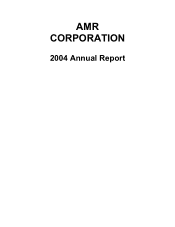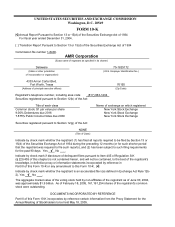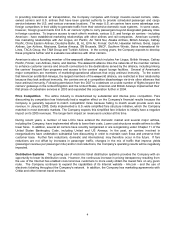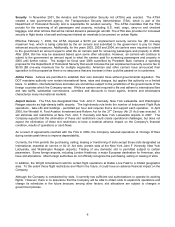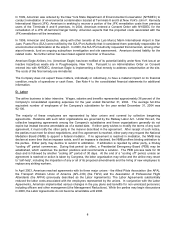American Airlines 2004 Annual Report Download - page 4
Download and view the complete annual report
Please find page 4 of the 2004 American Airlines annual report below. You can navigate through the pages in the report by either clicking on the pages listed below, or by using the keyword search tool below to find specific information within the annual report.
1
PART I
ITEM 1. BUSINESS
AMR Corporation (AMR or the Company) was incorporated in October 1982. AMR’s operations fall almost entirely
in the airline industry. AMR's principal subsidiary, American Airlines, Inc. (American), was founded in 1934. On
April 9, 2001, American (through a wholly owned subsidiary, TWA Airlines LLC (TWA LLC)) purchased
substantially all of the assets and assumed certain liabilities of Trans World Airlines, Inc. (TWA), the eighth largest
U.S. carrier at the time of the transaction.
American is the largest scheduled passenger airline in the world. At the end of 2004, American provided
scheduled jet service to approximately 150 destinations throughout North America, the Caribbean, Latin America,
Europe and the Pacific. American is also one of the largest scheduled air freight carriers in the world, providing a
wide range of freight and mail services to shippers throughout its system.
In addition, AMR Eagle Holding Corporation (AMR Eagle), a wholly-owned subsidiary of AMR, owns two regional
airlines which do business as "American Eagle” -- American Eagle Airlines, Inc. and Executive Airlines, Inc.
(Executive) (collectively, the American Eagle carriers). American also contracts with three independently owned
regional airlines, which do business as the “American Connection” (the American Connection carriers). The
American Eagle carriers and the American Connection carriers provide connecting service from eight of
American's high-traffic cities to smaller markets throughout the United States, Canada, Mexico and the Caribbean.
AMR Investment Services, Inc. (AMR Investment), a wholly-owned subsidiary of AMR, is responsible for the
investment and oversight of assets of AMR’s U.S. employee benefit plans, as well as AMR’s short-term
investments. It also serves as the investment manager of the American AAdvantage Funds, a family of mutual
funds with both institutional and retail shareholders, and provides customized fixed income portfolio management
services. As of December 31, 2004, AMR Investment was responsible for the management of approximately
$36.5 billion in assets, including direct management of approximately $16.4 billion in short-term fixed income
investments. The Company anticipates that, on March 1, 2005, the names of both AMR Investment Services, Inc.
and the American AAdvantage Funds will change to American Beacon Advisors, Inc. and American Beacon
Funds, respectively.
A. Recent Events
The Company has incurred very large operating and net losses during the past four years, as shown in the
following table:
Year ended December 31,
(in millions) 2004 2003 2002 2001
Operating loss $ (144) $ (844) $ (3,330) $ (2,470)
Net loss (761) (1,228) (3,511) (1,762)
These losses reflect, among other things, a substantial decrease in the Company's revenues in 2001 and 2002.
This revenue decrease was primarily driven by (i) a steep fall-off in the demand for air travel, particularly business
travel, primarily caused by weakness in the U.S. economy, (ii) reduced pricing power, resulting mainly from greater
cost sensitivity on the part of travelers (especially business travelers), increasing competition from low-cost
carriers (LCCs) and the continuing increase in pricing transparency resulting from the use of the Internet and (iii)
the aftermath of the terrorist attacks of September 11, 2001 (Terrorist Attacks), which accelerated and
exacerbated the trend of decreased demand and reduced industry revenues. The Company believes that its
reduced pricing power resulting from the factors listed in clause (ii) above will persist indefinitely and possibly
permanently.
Passenger traffic rebounded in 2003 and 2004, reflecting a general improvement in the U.S. and several other
economies served by the Company, the diminishing impact of the Terrorist Attacks on demand and lower fares.
However, the Company’s pricing power remained depressed in 2003 due to a continuation of the factors listed in
clause (ii) of the preceding paragraph, and declined in 2004 due to significant increases in overall industry capacity
that exceeded the growth in demand, and more frequent and more deeply discounted fare sales initiated by
competitors, including competitors currently operating under the protection of Chapter 11 of the Bankruptcy Code.

